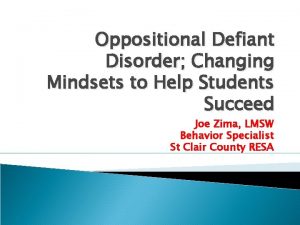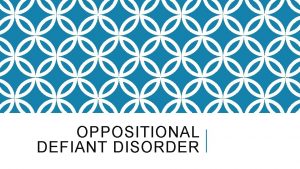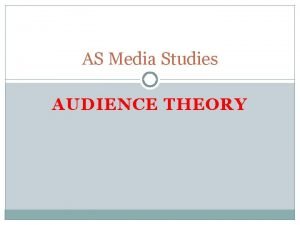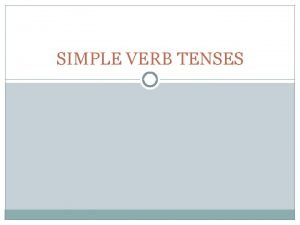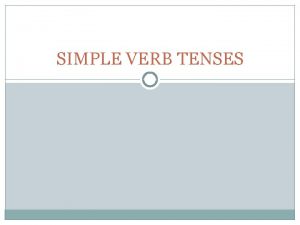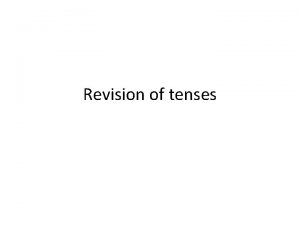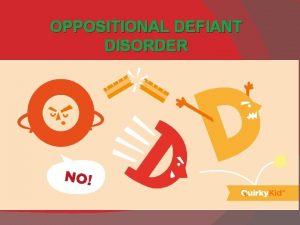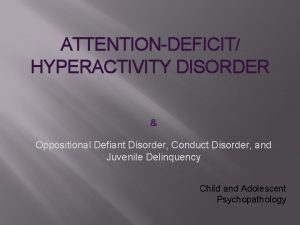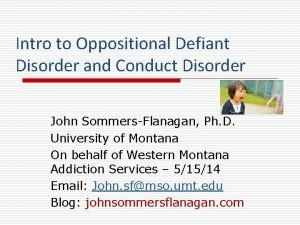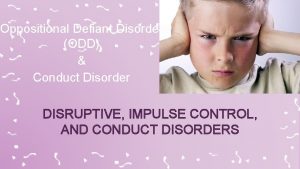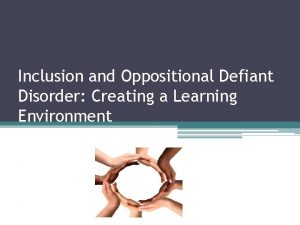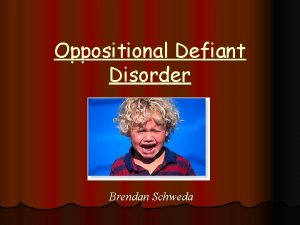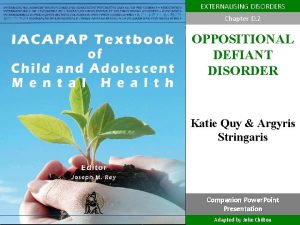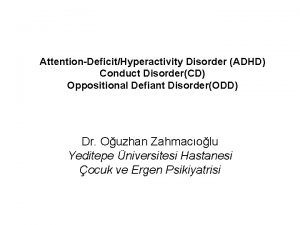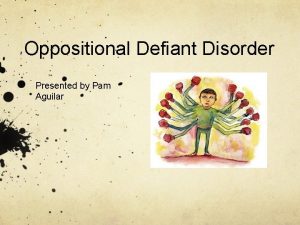Oppositional Defiant Disorder Andrea Janet Liz and Sonia
















- Slides: 16

Oppositional Defiant Disorder Andrea, Janet, Liz and Sonia

Agenda O Knowledge Tree Mind Map O Definition O Characteristics and Behaviours O Comorbidity O Causes O Diagnosis O Treatment O Help for Teachers

Objectives O Be able to define it, recognize it O Provide tools on how to work with a child with ODD

Definition O “Childhood disorder characterized by an ongoing and persistent pattern of hostile, noncompliant, and resistant behaviors manifested toward authority figures” (Masse & Mc. Neil, 2008).

Characteristics Individuals with ODD are often described as: O Defiant, spiteful, negative, hostile, verbally aggressive, usually aimed at parents and other authority figures. (“ODD: A Guide for Families”, 2009)

Sound Familiar? What is the difference between ODD & Conduct Disorder? http: //www. polleverywhere. com/my/polls Which of the following features is NOT associated with ODD? a) Deliberately annoying people b) Spiteful attitude and revenge seeking c) Aggression to animals, property or others d) Excessive arguments with adults

Behaviours include: O Frequent temper tantrums O Excessive arguments with adults O Actively refusing to comply with requests and rules O Often questioning rules O Deliberately annoying or upsetting others O Often touchy or annoyed by others O Blaming others for their mistakes O Frequent outbursts of anger and resentment O Spiteful attitude and revenge seeking *typically do not engage in delinquent behaviour!

Comorbidity Common other conditions that coexist are: O O ADHD Anxiety Disorders Learning & Language disorders Mood Disorders (ie: Depression or bipolar) Which is the most common disorder with ODD? http: //www. polleverywhere. com/my/polls *Often a precursor to Conduct Disorder.

Causes O Biological O Psychological O Social and Environmental Factors

Diagnosis O DSM-5 O Under 5 yrs O Over 5 yrs

How often is often? According to the DSM-V, children with ODD show an ongoing pattern of extreme negativity, hostility, and defiance that: O Is constant O Lasts at least 6 months O Is excessive compared to what is usual for the child’s age O Is disruptive to the family and school O Is usually directed toward an authority figure (parent, coach, teacher, principal)

Treatment O Counseling O Skills Training O Changes at Home O School Support O Treatment of Co- morbid Health Issues (medication)

Strategies in the classroom: Prevention. Structure. Reasonable limits, consistent consequences. Praise. Positive Reinforcement. Address Motivational difficulties. Social Skills instruction. Time outs. Breaks. (for you!) Behaviour Contracts. Outside Agencies.

“The challenge of teaching requires educators to understand address the unique characteristics of all students, including those who exhibit oppositional and defiant behaviors” (Salend & Sylvestre, 2005)

References O American Academy of Child & Adolescent Psychiatry O O O O www. aacap. org Mayo Clinic: http: //www. mayoclinic. com/health/oppositional-defiantdisorder/DS 00630 http: //emedicine. medscape. com/article/918095 overview#aw 2 aab 6 b 2 Rhode, Ginger. (1998) The Tough Kid Book-Practical Classroom Management Strategies. Longmont: Sopris. Salend, S. , & Sylvestre, S. (2005). Understanding and Addressing Oppositional and Defiant Classroom Behaviors. Teaching Exceptional Children, 37, 32 -39. http: //specialed. about. com/od/behavioremotional/a/odd. htm Trix, Victoria. (2009) Strategies for Teaching Children with Oppositional Defiant Disorder. http: //www. brighthub. com/education/special/articles/26631. aspx Woolsey, Wendy. Strategies to Work with Students with Oppositional Defiant Disorder. http: //www. cec. sped. org/AM/Template. cfm? Section=Home&CONTE NTID=2426&TEMPLATE=/CM/Content. Display. cfm

Questions?
 Oppositional defiant disorder in adults
Oppositional defiant disorder in adults Idea definition of emotional disturbance
Idea definition of emotional disturbance Oppositional gaze definition
Oppositional gaze definition Odd dsm5 criteria
Odd dsm5 criteria Defiant spirit meaning
Defiant spirit meaning Factitious disorder vs somatic symptom disorder
Factitious disorder vs somatic symptom disorder Bell hooks oppositional gaze
Bell hooks oppositional gaze Oppositional reading media example
Oppositional reading media example Sonia kumari dog
Sonia kumari dog Junes portfolio includes 177 shares
Junes portfolio includes 177 shares Ann plays handball very well
Ann plays handball very well I ______ to the mall after school.
I ______ to the mall after school. Put each verb in brackets
Put each verb in brackets Mary elizabeth porray
Mary elizabeth porray Sonia kabana
Sonia kabana Sonia sehgal md
Sonia sehgal md Lomekwian
Lomekwian
